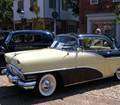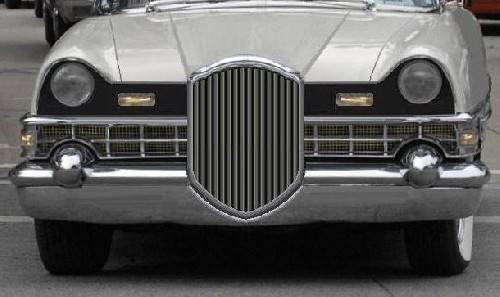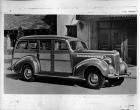|
Re: Packard & Hudson proximity
|
||||
|---|---|---|---|---|
|
Home away from home

|
Phil makes a very good point about the Conner move resulting from loss of the Briggs account. Most people just blame it on management.
I think Packard had too many negatives to deal with at once. Studebaker was able to diversify out of the car business and did well. Packard was trying to do the same but didn't have the time. However, they were far too late with the two speed transmission. They should have started that by 51 and then gone to three speeds by 55, even if it meant buying the engineering from Borg Warner. Granted the UL can be made to work correctly with a few valve body updates, but customers and dealers are not in a position understand that.
Posted on: 2013/2/16 11:31
|
|||
|
||||
|
Re: Packard & Hudson proximity
|
||||
|---|---|---|---|---|
|
Home away from home

|
Packard's automatic transmission situation has always been a puzzlement. I read that the company actually began work on developing an automatic in the mid 1930s. What happened? Oldsmobile had a working Hydromatic by 1940, which segwayed into the rest of the GM line during the 1940s. If Packard could develop a working air conditioner for its cars by 1940, it think it would have been a lot wiser to have funneled its resources into the transmission first and beat General Motors by offering an automatic by 1939, and followed up on it by making the automatic standard equipment on its Clipper and senior Packards by 1941 and beyond. That might have been able to make some difference in the future, but who really knows.
Here is one more thought. Studebaker was instrumental in bringing Mercedes Benz to the American shores in the 1950s. Wouldn't it have been interesting to add the Mercedes lineup with Packards on their show room floors. At least that way Packards would have looked a lot more modern!
Posted on: 2013/2/16 15:59
|
|||
|
You can make a lot of really neat things from the parts left over after you rebuild your engine ...
|
||||
|
||||
|
Re: Packard & Hudson proximity
|
||||
|---|---|---|---|---|
|
Home away from home
|
Interesting you bring up the Mercedes Benz subject. I have mentioned before that maybe a better way to go for Packard would be to have their post 1958 cars base on senior Mercedes. Acknowledge that the Mercedes design was dated, but they continued to sell to a limited high end market. A reworked Mercedes body shell with Packard influences, to me, may have been the route to go. Better than the foot ball stadium sized Lincoln bodies. The Mercedes based Packards could have had the classic, but modern styling and high quality interiors. The Mercedes body would have lent itself to a classic vertical Packard grille treatment. Nice to dream, isn't it?
(o{}o)
Posted on: 2013/2/16 22:39
|
|||
|
We move toward
And make happen What occupies our mind... (W. Scherer) |
||||
|
||||
|
Re: Packard & Hudson proximity
|
||||
|---|---|---|---|---|
|
Home away from home

|
Another work-up for '57. Side foil wrapping to front instead of the gold grill mesh might have looked better, sufficient engine cooling air coming through the vertical grill. Body color around headlights might have looked better than black. Those rectangular elements flanking the grill are "thingies"... maybe lights, maybe non-functional adornments. Something to fill in the space.
Posted on: 2013/2/17 19:26
|
|||
|
||||
|
Re: Packard & Hudson proximity
|
||||
|---|---|---|---|---|
|
Home away from home

|
The American luxury market eventually chose Mercedes as the standard but not until the 70s and 80s. Read where M-B objected to Packard being resurrected in the early 60s because they didn't want the competition.
Lack of an automatic may have hurt more than the V8. From the intro of the Twelve to the end, Packard only trailed Cadillac in horsepower in '40 and '51-54 and for the most part the two companies were very close except for '53-54 when Cadillac pulled noticeably ahead. Buick sold like gangbusters with its straight 8 through 1952 so the V-configuration wasn't an absolute must, at least not until '53. Packard picked up sales momentum in '53 despite lack of a V8. Packard's miserable '54 performance may have been due more to Cadillac's eye-catching redesign. Packard had no automatic in '41-'42 and '46-'49, a steadily growing problem. While take rates for a Cadillac with automatic took a little while to pick up, by 1947 96% of Cadillacs came with one and the division enjoyed a waiting list for its cars. Packard understandably hustled to get out the Ultramatic before the OHV V8. I think the Hudson JV would have helped, the extent to which depends on how much of Packard's '55 issues were due specifically to Conner. My guess is not as much as has been assumed. A fair amount of the '55 quality problems had nothing to do with Conner and would have happened had the cars been assembled in Christopher's best laid out plant. JV stamping cost savings with Hudson would have been good. Tremendous savings would have come with a shared platform and body shell, even more with a common assembly line. My personal feeling is that management, product planning and design did Packard in and these "big 3" personnel began their handiwork as early as the mid to late 30s. Clipper certainly was late, and by Darrin's own admission visually not what it could have been. I don't think absence of WW2 would have made much difference vis-?-vis Cadillac, which by 1942 had three 6-pass 4-dr body styles and wheelbases plus a coupe, convertible and limo line, and good visual differentiation from Buick and Olds. The '48s suffered from the same conspirators, which Nance replaced with his own in '52 and they proceeded to let a sorely needed '54 program slip by and rushed the '55s because they took too long figuring out what they wanted to do. Packard's big 3 were also responsible for the company having NO car to match the Cadillac 60 Special from 1938 to 1956. That says it all. Packard, once America's luxury car leader, for 18 years had no direct response to the flagship of the American luxury car fleet. My guess is that all the merger possibilities could have worked. Packard-Nash, Packard-Hudson, Packard-Studebaker or some combo. And with or without the Ford-Chevy battle, Conner, WWII, production caps, Wilson steering defense contracts, Big 3 purchasing power and on and on. Even as Packard was failing, other small players were defying gravity and finding a place in the market.
Posted on: 2013/2/17 19:37
|
|||
|
||||
|
Re: Packard & Hudson proximity
|
||||
|---|---|---|---|---|
|
Home away from home
|
Nice looking front end styling. I always thought that if Packard had used the Request styling for their senior cars it would have enhanced the Packard name and let the Clippers compete better too. There would have been more appearance difference between the two lines. A person paying many more dollars for a Packard would not want it confused as a lesser Clipper, but there would still be enough family styling to benefit the Clipper. Thanks.
(o{}o)
Posted on: 2013/2/17 22:24
|
|||
|
We move toward
And make happen What occupies our mind... (W. Scherer) |
||||
|
||||
|
Re: Packard & Hudson proximity
|
||||
|---|---|---|---|---|
|
Home away from home

|
Hi
Good points all around! What an interesting discussion this became. Here's a scenario to consider. 1954 was too late to affect an integrated, well-functioning merger of Packard and Hudson by '55- '56 given their diminished financial conditions and market percentages but a few years earlier could have yielded a different story. Their proximity would have been an advantage since there was sufficient square footage between their plants to layout the optimum operations for body, engine, chassis, sub-assemblies, etc. Among the mistakes to be rectified would have been body making operations brought back from Briggs as soon as an adequate facility could be outfitted for it. Hudson bodies were still an in-house effort though I seem to recall Murray Corporation had some involvement with the Stepdowns as well. When could all this possibly been executed successfully? 1948-50. It was in those years their combined production was over 240,000 cars for the '48-'49, among their strongest postwar years with new products, Hudson being volume dominant. From '50 on, the slide picked up speed rapidly. With George Christopher out of the way, Hugh Ferry and A.E. Barit would have set in motion an integration program for 1951 or 1952 introduction with shared bodies the major component, a new V8 engines then or within a year. Hudson models would cover the complete medium-priced segment from Pontiac/Dodge/Mercury through Buick Roadmaster/Chrysler New Yorker/non-Cosmopolitan Lincoln. Packard would return exclusively to the luxury market, going model-for-model opposite all Cadillacs/Lincoln Cosmopolitan/Imperials (which weren't a real factor but would be shortly). The body architecture would be that of the '51 Packards with engineering elements from Hudson such as step-down floor pans and semi-unibody construction, as much as practical without limiting body selection or further restyles. Each would have it's own defined styling theme. If Ultramatic transmission was already in production, it would be offered throughout. If not, development of an automatic transmission in conjunction with Borg-Warner would be engaged, much as Ford and Studebaker did. Automatic transmission development and manufacture was a massively expensive proposition for a company as small as Packard was. While they definitely needed the automatic to affectively compete, they were unlikely to ever have the volume to make it's manufacture cost-affective without shopping to other makers to gain more. The biggest issue would an ohv V8 engine family to supplant all the L-head in-lines, although a flathead six could be retained as long as it was offered by the competition. Both the new V8 and even the six would be shopped to trucker makers to help amortized the development and production costs as well as create an ongoing revenue stream. In reorganizing their plants and operations, the major objective would have been to reduce their overhead and break-even points to minimize losses and/or allow small profits even the leanest years. This would also be done with the idea that while competing with the Big Three makes, planned volumes would generally remain a smaller percentage of their totals. In this way, overbuilding for production numbers that were unrealistic against the market saturation of the majors wouldn't snatch major losses from the mouth of satisfactory profits. Along with integrating all the administrative and support functions, the R & D and styling departments would have to be developed to a highly dynamic states rarely in affect before at either company. Given the styling regimen of the three-year cycle becoming the norm, bucking that trend would have been futile in the '50's, even into the '60's. American was in an optimistic, give-'em-hell/can-do-anything mindset; frequent changes and even flamboyant styling were perceived as consistent with this dynamic outlook. Automakers such as Rolls-Royce and Mercedes-Benz were exempt from this idea being 'foreign' and perhaps a bit suspect, regardless of their quality. What of the other independents? Nash-Kelvinator was the better managed, odd-styling notwithstanding, had seized upon an avenue that would come to be it's salvation as market emphasis drastically changed in the latter part of the decade. The addition of it's Rambler would have been ideal once the Hudson and Packard integration had been fully consummated and stabilized. A small car that did not take on the low-priced-three head-on was the only way a smaller volume producer was going to compete in that most cut-throat of segments. As long as Chevy/Ford/Plymouth moved upward in size and performance and away from modest basic transportation qualities, they affectively created a void even their most stripped-down full-sized cars could not fulfill. Nash and it's Rambler, once included, could remain anchored in Kenosha building fully unibody compacts and sharing it the advanced engineering and styling developed in Detroit. Other questions of whether Studebaker had potential place in a merger, whether a Chrysler acquisition of Packard held any advantage for either, views on Messrs Ford damaged relationship and Lincoln will be posted later. Steve
Posted on: 2013/2/18 13:28
|
|||
|
||||
|
Re: Packard & Hudson proximity
|
||||
|---|---|---|---|---|
|
Forum Ambassador

|
I generally avoid these speculations on "what could have been"; not that they're not interesting but rather than they are just endless. But let me add a point to consider that I haven't seen yet mentioned; Hudson was committed to unibody construction when it went to the stepdown style. I'm told that designing and tooling for a new unibody structure is far more expensive than body-on-frame; the costs in introducing the Jet left Hudson without resources to update their body/frame structure which was already long overdue for replacement. If that's true and Hudson and Packard combined, then either Hudson would have to revert to body-on-frame or Packard to unibody to hope to get enough volume to amortize costs over what had become an industry standard of "new" styling every 3 years or so, in either case the costs would no doubt have been far too high to give a chance of recovery of costs. If all of this is true, then Hudson combining with the only other unibody maker at the time, Nash, makes a lot more sense.
Earlier in this thread I think I read that Buick sales without a V8 were good thru 1952. Check me out on this but I believe 1952 was a very poor year for Buick sales, their worst since 1942.
Posted on: 2013/2/18 14:41
|
|||
|
||||
|
Re: Packard & Hudson proximity
|
||||
|---|---|---|---|---|
|
Home away from home

|
Blaming Christopher and Gilman is like blaming MacCauley for hiring them. Fact of the matter is Packard relied on fat margins for profit and those margins evaporated due to technological evolution. I've know people who said the last good Packard was in 1903 and others who said everything after 1914 was shxt.
Even Turnquist realized that Packard would have been gone without the 120. I don't know what the numbers were for Cadillac as a stand alone company, but the V-16 didn't seem to help them much. One thing I do know is that people have told me they thought Packard was a "snob car" whereas Cadillac was more for the up and coming. So Packard suffered heavily from brand maturity. Bolt for bolt, by 1940 the Cadillac was more robust and held up better than the Packard. But still I don't think that accounted for the decline. Brands come and go. Remember when the SAAB was the car for people who didn't know anything about cars except what they were preached by stupid car magazines like R&T? At Ford management cried the blues because there was no more market for a "Standard Ford." They thought that should be their core product. Now they rely on a gargantuan pick up truck market that didn't exist until the quintissential big American sedan became history. Finally, I knew this guy and he had a 49 Caddy 75. Two blocks behind the wheel of that car and you knew Packard was finished. That OHV V-8 made the 75 chassis so competent and restful that the only comparison would be between the Packard Twelve and a Buick Special. It is a true classic. Yet they only made it for a half year.
Posted on: 2013/2/18 18:32
|
|||
|
||||

 (28.05 KB)
(28.05 KB)







